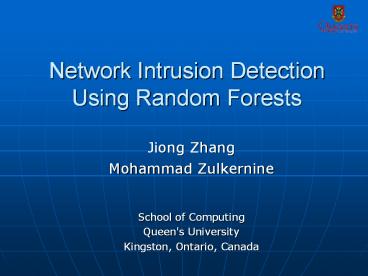Network Intrusion Detection Using Random Forests PowerPoint PPT Presentation
1 / 19
Title: Network Intrusion Detection Using Random Forests
1
Network Intrusion Detection Using Random Forests
- Jiong Zhang
- Mohammad Zulkernine
- School of Computing
- Queen's University
- Kingston, Ontario, Canada
2
Outline
- Motivation
- Intrusion detection system
- Data mining meets intrusion detection
- Proposed architecture
- Challenges and solutions
- Experimental results
- Conclusion and future work
3
Motivation
- Intrusion Prevention System (firewall) can not
prevent all attacks.
Intruder
Victim
Intruder
Firewall
Internet
4
Motivation (contd.)
- Statistical data for intrusions
- Total losses of 2004 (reported) 141,496,560.
- Source FBI survey for Year 2004
- 50 of security breaches are undetected.
- Source FBI Statistics for Year 2000
5
Intrusion Detection Techniques
- Misuse Detection
- Extracts patterns of known intrusions
- Cannot detect novel intrusions
- Has low false positive rate
- Anomaly Detection
- Builds profiles for normal activities
- Uses the deviations from the profiles to detect
attacks - Can detect unknown attacks
- Has high false positive rate
6
Network Intrusion Detection System (NIDS)
- Monitors network traffic to detect intrusions
- Monitors more targets on a network
- Detects some attacks that host-based systems miss
- Does not affect network operations
7
Current NIDS
- Many current NIDSs (like snort)
- Rule-based
- Unable to detect novel attacks
- High maintenance cost
8
Rule Based vs. Data Mining
- Rule based systems
- Data mining based systems
Intrusion Data
Security Experts
Rules
Labeled Data
Data Mining Engine
Patterns
9
Data Mining Meets Intrusion Detection
- Extract patterns of intrusions for misuse
detection - Build profiles of normal activities for anomaly
detection - Build classifiers to detect attacks
- Some IDSs have successfully applied data mining
techniques in intrusion detection
10
Proposed Architecture
Database (On line)
Alarms
Packets
Audited data
- Networks
Alarmer
Detector
Sensors
On-line Pre- Processors
Feature vectors
Patterns
On line
Off line
Training data
Feature vectors
Pattern Builder
Data Set
Off-line Pre- processor
Database (Off line)
Architecture of the proposed NIDS
11
Random Forests
- Unsurpassable in accuracy among the current data
mining algorithms - Runs efficiently on large data set with many
features - Gives the estimates of what features are
important - No nominal data problem
- No over-fitting
12
Imbalanced Intrusion
- Problems
- Higher error rate for minority intrusions
- Some minority intrusions are more dangerous
- Need to improve the performance for the minority
intrusions - Proposed Solution
- Down-sample the majority intrusions and
over-sample the minority intrusions
13
Feature Selection
- Essential for improving detection rate
- Reduces the computational cost
- Many NIDSs select features by intuition or the
domain knowledge
14
Feature Selection over the KDD99 Dataset
- Calculate variable importance using random
forests. - Select the 38 most important features in
detection.
15
Some Features
- The two most important features
- Feature 3. service type, such as http, telnet,
and ftp - Feature 23. count, connections to the same
host as the current one during past two seconds - The three least important features
- Feature 7. land, 1 if connection is from/to the
same host/port 0 otherwise - Feature 20. num_outbound_cmds, of outbound
commands in an ftp session - Feature 21. is_hot_login, 1 if the login belongs
to the hot list 0 otherwise
16
Parameter Optimization for Random Forests
- Optimize the parameter Mtry of random forests to
improve detection rate. - Choose 15 as the optimal value, which reaches the
minimum of the oob error rate.
17
Performance Comparison on the KDD99 Dataset
- Our approach provides lower overall error rate
and cost compared to the best KDD99 result. - Feature selection can improve the performance of
intrusion detection.
18
Conclusion and Future Work
- Random forests algorithm can help improve
detection performance and select features. - Sampling techniques can reduce the time to build
patterns and increase the detection rate of
minority intrusions. - In future, we will focus on anomaly detection and
a multiple classifier architecture.
19
(No Transcript)

